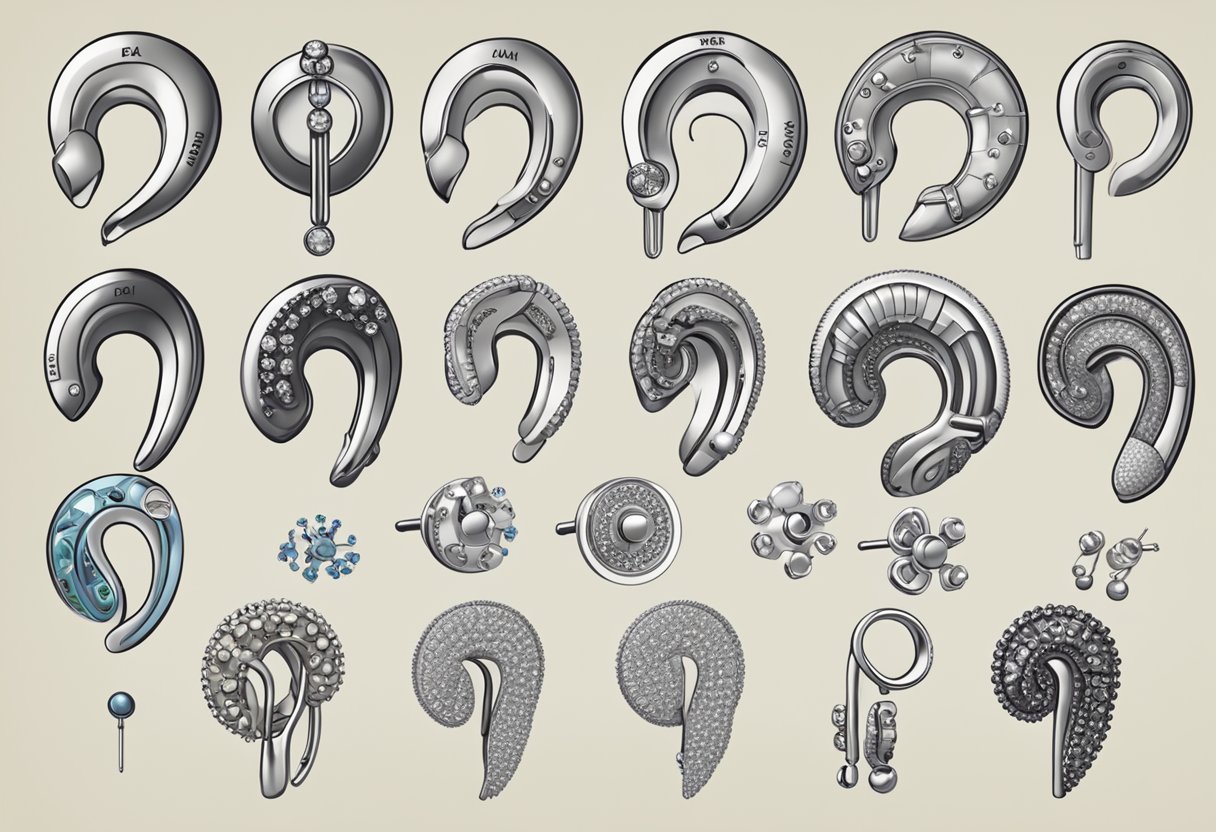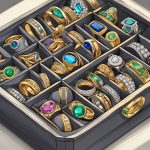Types Of Ear Piercings
Ear piercings have been around for centuries and are a popular form of self-expression. Whether it’s a simple lobe piercing or a more intricate helix piercing, the possibilities are endless. With so many different types of ear piercings available, it can be overwhelming to choose the right one.
Understanding the Basics of Ear Piercings is important before deciding on a piercing. Ear piercings are typically done with a needle, and it’s important to choose a reputable piercer who follows proper safety procedures. The healing time for ear piercings can vary depending on the location and type of piercing. It’s crucial to follow aftercare instructions carefully to avoid infection or other complications.
Popular Ear Piercing Styles include traditional lobe piercings, cartilage piercings, and industrial piercings. Each piercing has its own unique look and level of pain associated with it. Some piercings, such as daith piercings, are said to have health benefits, such as reducing migraines.
Key Takeaways
- Understanding the Basics of Ear Piercings is crucial before getting pierced.
- Popular Ear Piercing Styles include traditional lobe piercings, cartilage piercings, and industrial piercings.
- Procedure and Safety, Jewelry and Customization, and Considerations Before Getting Pierced are important factors to consider before getting an ear piercing.
Understanding the Basics of Ear Piercings

Ear Anatomy
Before delving into the different types of ear piercings, it’s important to understand the anatomy of the ear. The ear is divided into three main parts: the outer ear, the middle ear, and the inner ear. The outer ear is the visible part of the ear that includes the earlobe and the helix, which is the curved rim of cartilage that surrounds the ear. The middle ear is the space behind the eardrum, and the inner ear is the part of the ear that contains the cochlea and the vestibular system.
Types of Ear Piercing
There are various types of ear piercings, ranging from traditional lobe piercings to more intricate cartilage piercings. Lobe piercings are the most common type of ear piercing, and they are typically done with a piercing gun or a needle. Other types of ear piercings include helix piercings, tragus piercings, daith piercings, rook piercings, and industrial piercings.
Piercing Options
When it comes to getting an ear piercing, there are a few options to consider. The first option is the type of piercing, which will depend on the individual’s style and preferences. The second option is the location of the piercing, which can vary based on the type of piercing and the individual’s ear anatomy. The third option is the method of piercing, which can be done with a piercing gun or a needle. It’s important to note that piercing guns are not recommended for cartilage piercings, as they can cause damage to the ear.
Overall, ear piercings can be a stylish and fun way to express one’s individuality. It’s important to do research and choose a reputable piercer to ensure a safe and successful piercing experience.
Popular Ear Piercing Styles
When it comes to ear piercings, there are plenty of options to choose from. Here are some of the most popular ear piercing styles:
Lobe Piercing
Lobe piercing is the most common type of ear piercing and is often the first piercing someone gets. It involves piercing the fleshy part of the earlobe. Lobe piercings can be done with a stud or hoop and can be single or multiple.
Helix Piercing
Helix piercing is done on the upper cartilage of the ear. It can be done on the outer or inner helix and can be single or multiple. Helix piercings can be done with a stud or hoop and can be combined with other piercings like forward helix or industrial piercing.
Tragus Piercing
Tragus piercing is done on the small piece of cartilage that protrudes from the ear canal. It can be done with a stud or hoop and is a popular choice for those who want a unique piercing that is still subtle.
Conch Piercing
Conch piercing is done on the inner cartilage of the ear. It can be done with a stud or hoop and is a popular choice for those who want a bold and noticeable piercing.
Industrial Piercing
Industrial piercing involves piercing the upper cartilage of the ear with two holes and connecting them with a barbell. It is a popular choice for those who want a unique and edgy piercing.
Daith Piercing
Daith piercing is done on the innermost cartilage fold of the ear. It can be done with a stud or hoop and is a popular choice for those who want a piercing that is hidden and subtle.
Rook Piercing
Rook piercing is done on the inner cartilage fold of the ear. It can be done with a stud or hoop and is a popular choice for those who want a piercing that is unique and eye-catching.
Overall, there are many different types of ear piercings to choose from, each with its own unique style and placement. It is important to choose a reputable piercer and follow proper aftercare to ensure a successful piercing experience.
Procedure and Safety
When it comes to ear piercings, safety is of utmost importance. It is crucial to choose a reputable and licensed piercer to ensure that the procedure is performed safely and hygienically. Below are some important factors to consider when getting an ear piercing.
Choosing a Piercer
Choosing a reputable piercer is essential to ensure that the procedure is performed safely. It is recommended to research the piercer’s credentials and reputation before scheduling an appointment. A reputable piercer will use sterilized needles and follow proper hygiene practices to minimize the risk of infection.
Piercing Process
The piercing process involves using a sterilized needle to create a hole in the earlobe or cartilage. The piercer will mark the spot where the piercing will be made and then use a needle to create the hole. It is important to note that piercing guns should not be used as they can cause more tissue damage and increase the risk of infection.
Aftercare Routine
Aftercare is crucial to ensure proper healing and minimize the risk of infection. The piercer will provide instructions on how to care for the piercing, which typically involves cleaning the area with saline spray or an aftercare lotion. It is important to avoid touching the piercing with dirty hands and to avoid swimming or submerging the piercing in water for at least a few weeks after the procedure.
Infections can occur if proper aftercare is not followed. Signs of infection include redness, swelling, and discharge. If an infection is suspected, it is important to seek medical attention promptly.
Healing time varies depending on the type of piercing, but it typically takes several weeks to a few months for the piercing to fully heal. It is important to avoid changing earrings too soon, as this can cause damage to the healing tissue.
In summary, choosing a reputable piercer, following proper aftercare, and being aware of the signs of infection are key to ensuring a safe and successful ear piercing.
Jewelry and Customization
When it comes to ear piercings, choosing the right jewelry is essential to achieve the desired look. There are various types of jewelry available in the market, ranging from earrings and studs to rings and hoops. Each type of jewelry has its own unique style and material, which can be customized to suit individual preferences.
Earrings and Studs
Earrings and studs are the most common types of jewelry for ear piercings. They come in various shapes and sizes, ranging from small diamond studs to large statement earrings. The material used for earrings and studs can vary from gold to silver to punk-rock inspired materials like stainless steel or titanium. The style of earrings and studs can also be customized to suit individual preferences, such as geometric shapes or floral designs.
Rings and Hoops
Rings and hoops are another popular type of jewelry for ear piercings. They are usually worn on the cartilage of the ear and come in various sizes and styles. Rings and hoops can be made of different materials, such as gold or silver, and can be customized with diamonds or other precious stones. Some people prefer to wear multiple rings or hoops on the same ear, creating a unique and personalized look.
Material and Style
The material and style of the jewelry used for ear piercings can have a significant impact on the overall look. For example, gold jewelry is often associated with a classic and elegant style, while punk-rock inspired materials like stainless steel or titanium can create a more edgy and alternative look. The style of the jewelry can also be customized to suit individual preferences, such as minimalist or bohemian-inspired designs.
In conclusion, choosing the right jewelry for ear piercings is crucial to achieve the desired look. Earrings and studs, rings and hoops, and the material and style of the jewelry can all be customized to suit individual preferences. With the right combination of jewelry and customization, anyone can create a unique and personalized look that reflects their personality and inspiration.
Considerations Before Getting Pierced
Before getting an ear piercing, it is important to consider several factors to ensure that the process goes smoothly and the piercing heals properly. Here are some things to keep in mind:
Pain and Healing
Different types of ear piercings have varying levels of pain and healing times. For example, a standard lobe piercing is generally considered to be relatively painless and takes about 4-6 weeks to heal, while a cartilage piercing can be more painful and take up to 6 months to heal completely. It is important to research the specific piercing you are interested in and understand the pain level and healing time associated with it.
Cost and Maintenance
The cost of getting an ear piercing can vary depending on the location and type of piercing. It is important to research the cost beforehand and ensure that it fits within your budget. Additionally, different types of piercings require different levels of maintenance, such as cleaning and avoiding certain activities during the healing process. It is important to understand the maintenance requirements of the piercing you are interested in and ensure that you are willing and able to follow them.
Cultural and Personal Significance
Ear piercings can hold cultural and personal significance for some individuals. It is important to consider the significance of the piercing and ensure that it aligns with your personal values and beliefs. Additionally, some workplaces and schools have policies regarding visible piercings, so it is important to research and understand any potential conflicts before getting a piercing.
Overall, it is important to do thorough research and consider all factors before getting an ear piercing. By doing so, you can ensure that the process goes smoothly and the piercing heals properly.






